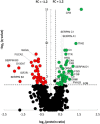Characterizing Patients with Recurrent Urinary Tract Infections in Vesicoureteral Reflux: A Pilot Study of the Urinary Proteome
- PMID: 31896675
- PMCID: PMC7050111
- DOI: 10.1074/mcp.RA119.001873
Characterizing Patients with Recurrent Urinary Tract Infections in Vesicoureteral Reflux: A Pilot Study of the Urinary Proteome
Abstract
Recurrent urinary tract infections (UTIs) pose a significant burden on the health care system. Underlying mechanisms predisposing children to UTIs and associated changes in the urinary proteome are not well understood. We aimed to investigate the urinary proteome of a subset of children who have vesicoureteral reflux (VUR) and recurrent UTIs because of their risk of developing infection-related renal damage. Improving diagnostic modalities to identify UTI risk factors would significantly alter the clinical management of children with VUR. We profiled the urinary proteomes of 22 VUR patients with low grade VUR (1-3 out of 5), a history of recurrent UTIs, and renal scarring, comparing them to those obtained from 22 age-matched controls. Urinary proteins were analyzed by mass spectrometry followed by protein quantitation based on spectral counting. Of the 2,551 proteins identified across both cohorts, 964 were robustly quantified, as defined by meeting criteria with spectral count (SC) ≥2 in at least 7 patients in either VUR or control cohort. Eighty proteins had differential expression between the two cohorts, with 44 proteins significantly up-regulated and 36 downregulated (q <0.075, FC ≥1.2). Urinary proteins involved in inflammation, acute phase response (APR), modulation of extracellular matrix (ECM), and carbohydrate metabolism were altered among the study cohort.
Keywords: Mass spectrometry; acute phase response; clinical proteomics; infectious disease; renal function or biology; urinary tract infection; urine analysis; vesicoureteral reflux.
© 2020 Vitko et al.
Conflict of interest statement
The authors declare that they have no conflicts of interest with the contents of this article
Figures





Similar articles
-
Urinary proteome analysis to exclude severe vesicoureteral reflux.Pediatrics. 2012 Feb;129(2):e356-63. doi: 10.1542/peds.2010-3467. Epub 2012 Jan 23. Pediatrics. 2012. PMID: 22271698
-
Urine interleukin-8 as a marker of vesicoureteral reflux in infants.Pediatrics. 2006 May;117(5):e863-7. doi: 10.1542/peds.2005-2051. Epub 2006 Apr 3. Pediatrics. 2006. PMID: 16585276
-
Sonographic assessment of the effect of vesicoureteral reflux and urinary tract infections on growth of the pediatric solitary kidney.J Pediatr Urol. 2015 Jun;11(3):145.e1-6. doi: 10.1016/j.jpurol.2015.02.012. Epub 2015 Mar 13. J Pediatr Urol. 2015. PMID: 25864614 Free PMC article.
-
Dimercaptosuccinic acid scan challenges in childhood urinary tract infection, vesicoureteral reflux and renal scarring investigation and management.Minerva Urol Nefrol. 2017 Apr;69(2):144-152. doi: 10.23736/S0393-2249.16.02509-1. Epub 2016 Jun 29. Minerva Urol Nefrol. 2017. PMID: 27355216 Review.
-
Do Various Treatment Modalities of Vesicoureteral Reflux Have Any Adverse Effects in Pediatric Patients? A Meta-Analysis.Urol Int. 2021;105(11-12):1002-1010. doi: 10.1159/000518603. Epub 2021 Sep 23. Urol Int. 2021. PMID: 34555831 Free PMC article.
Cited by
-
Proteomic and metabolomic profiling of urine uncovers immune responses in patients with COVID-19.Cell Rep. 2022 Jan 18;38(3):110271. doi: 10.1016/j.celrep.2021.110271. Epub 2021 Dec 28. Cell Rep. 2022. PMID: 35026155 Free PMC article.
-
New label-free methods for protein relative quantification applied to the investigation of an animal model of Huntington Disease.PLoS One. 2020 Sep 4;15(9):e0238037. doi: 10.1371/journal.pone.0238037. eCollection 2020. PLoS One. 2020. PMID: 32886703 Free PMC article.
-
A High-Throughput Method for Screening Peptide Activators of G-Protein-Coupled Receptors.ACS Omega. 2024 Nov 22;9(49):48471-48479. doi: 10.1021/acsomega.4c07071. eCollection 2024 Dec 10. ACS Omega. 2024. PMID: 39676964 Free PMC article.
-
Recent progress in mass spectrometry-based urinary proteomics.Clin Proteomics. 2024 Feb 22;21(1):14. doi: 10.1186/s12014-024-09462-z. Clin Proteomics. 2024. PMID: 38389064 Free PMC article. Review.
-
Urinary Proteomics for Discovery of Gastric Cancer Biomarkers to Enable Precision Clinical Oncology.OMICS. 2023 Aug;27(8):361-371. doi: 10.1089/omi.2023.0077. Epub 2023 Aug 9. OMICS. 2023. PMID: 37579183 Free PMC article.
References
-
- Neal D. E., Jr. (1999) Host defense mechanisms in urinary tract infections. Urol. Clin. North Am. 26, 677–686, vii - PubMed
-
- American Urological Association Mangement and Screening of Primary Vesicoureteral Reflux in Children. http://www.auanet.org/guidelines/vesicoureteral-reflux-. (2010-reviewed-and-validity-confirmed-2017)
-
- Peters C. A., Skoog S. J., Arant B. S. Jr.; Copp H. L., Elder J. S., Hudson R. G., Khoury A. E., Lorenzo A. J., Pohl H. G., Shapiro E., Snodgrass W. T., and Diaz M. (2010) Summary of the AUA Guideline on Management of Primary Vesicoureteral Reflux in Children. J. Urol. 184, 1134–1144 - PubMed
Publication types
MeSH terms
Substances
Grants and funding
LinkOut - more resources
Full Text Sources
Medical
Miscellaneous

